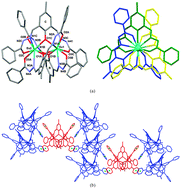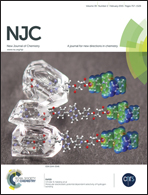Triply phenoxo bridged Eu(iii) and Sm(iii) complexes with 2,6-diformyl-4-methylphenol-di(benzoylhydrazone): structure, spectra and biological study in human cell lines†
Abstract
Two dinuclear lanthanide(III) complexes, [M2(HL)3] (M = Sm(III) (1), Eu(III) (2); H3L, 2,6-diformyl-4-methylphenol-di(benzoylhydrazone)) were generated with good yield and characterised systematically. The single crystal X-ray structure determination of [Eu2(HL)3] (2) confirmed the tricapped trigonal prismatic geometry of the N3O6 coordination environment around europium. Indeed, Eu(1) and Eu(2) are bridged by phenolato-O belonging to the p-cresol ring, by deprotonated ‘enol’ groups from the benzoyl hydrazide part and by the imine-N centres. A temperature dependent magnetic study suggested that anti-ferromagnetic coupling occurs between the two Eu(III) ions and the magnetic moment was found to vary from 0.48 B.M. at 5 K to 3.03 B.M. at 300 K. Electron paramagnetic resonance spectroscopy confirmed that anti-ferromagnetic coupling occurs between the atoms of Eu(III) and Sm(III). Both the complexes show emission in the visible range. The ligand, H3L and the complexes exhibit anti-mycobacterial activity against M. tuberculosis H37Rv (ATCC 27294) and M. tuberculosis H37Ra (ATCC 25177) strains. The molecular docking of H3L with the enoyl acyl carrier protein reductase of M. tuberculosis H37Rv (PDB ID: 4U0K) was examined and the best docked pose of H3L was shown to have one hydrogen bond with Thr196 (2.03 Å).


 Please wait while we load your content...
Please wait while we load your content...